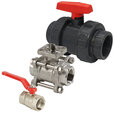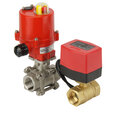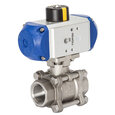Ball Valve Overview
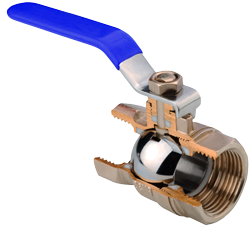
Figure 1: Ball valve sectional view
A ball valve is a shut-off device that regulates the flow of a liquid or gas using a rotating ball with a hole. By turning the ball a quarter turn (90 degrees) around its axis, the valve either opens or closes, allowing the medium to pass through or blocking it. Ball valves are known for their long lifespan and provide dependable sealing throughout their use, even when left unused for extended periods. They are more resistant to contaminated media than most other valve types.
Certain types of ball valves are also employed as control valves. This use is less frequent due to the relatively limited precision in controlling flow rates compared to other control valve types. However, ball valves have some advantages in this regard. For instance, they maintain reliable sealing even when the media is dirty. Figure 1 illustrates a cross-section of a ball valve.
Table of contents
- Ball valve working principle & components
- Automatic ball valves
- Ball valve housing materials
- Seals and O-rings
- High-pressure ball valves
- Ball valve connection types
- Approvals
- FAQs
View our online selection of ball valves!
Ball valve working principle & components
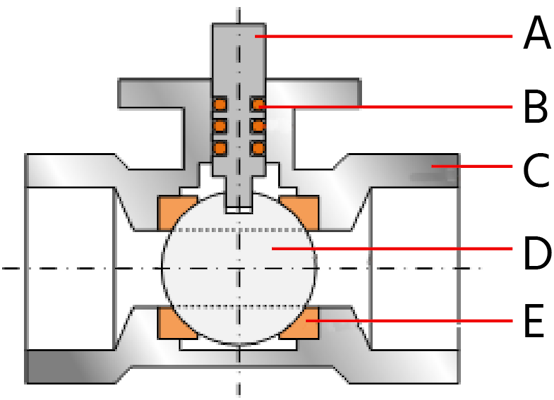
Figure 2: Ball valve diagram: stem (A), o-rings (B), housing (C), ball (D), and seat (E).
It is important to know the five main ball valve parts to understand the working principle of a ball valve. The diagram of the ball valve in Figure 2 shows these five main components.
- Valve stem (A): The valve stem connects the actuator (e.g., handle or actuator (electric or pneumatic)) to the ball.
- O-rings (B): O-rings on the valve's seat help prevent leakage.
- Housing (C): The housing supports all the valve's inside components and protects them from application and environmental conditions.
- Ball (D): The ball has a hollow bore through which fluid can flow when the valve is opened.
- Seat (E): The seat supports and seals the ball component.
When the valve stem is turned a quarter-turn the bore is either open to the flow allowing media to flow through or closed to prevent media flow. A ball valve's circuit function, housing assembly, ball design, and operation types all impact its operation and are discussed below.
Ball valves are more popular as a shut-off valve than, for example, the gate valve. For a complete comparison, read our gate valve vs. ball valve article.
Circuit function
The valve may have two, three or even four ports (2-way, 3-way, or 4-way). The vast majority of ball valves are 2-way and manually operated with a lever. The lever is in line with the pipe when the valve is opened. In the closed position, the handle is perpendicular to the pipe. The ball valve flow direction is simply from the input to the output for a 2-way valve. Manually operated ball valves can be quickly closed and therefore there is a risk of water hammer with fast-flowing media. Some ball valves are fitted with a transmission. The 3-way valves have an L-shaped or T-shaped bore, which affects the circuit function (flow direction). This can be seen in Figure 3. As a result, various circuit functions can be achieved such as distributing or mixing flows. A 90-degree ball valve has two ports that are positioned at a 90-degree angle.
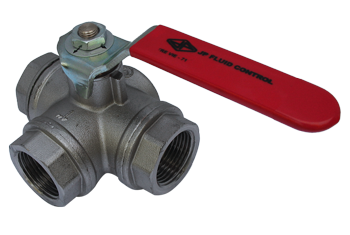
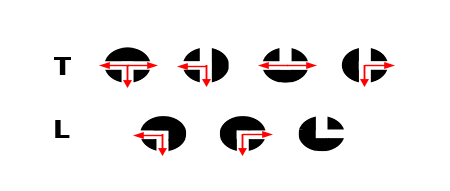
Figure 3: Example of a 3-way ball valve and the circuit functions for a T-bore and L-bore.
Housing assembly
The assembly of the valve housing can be divided into three commonly used designs: one-piece, two-piece, and three-piece housings. The difference is how the valve is assembled and this affects the possibilities for maintenance or repair. The operation of the valves is the same in each embodiment.
- One-piece: This is the cheapest variant. The two parts which enclose the ball are pressed or welded. The valves can not be opened for cleaning or maintenance. This type is generally used for low-demanding applications.
- Two-piece: Two-piece valves can be disassembled for cleaning, servicing, and inspection. Often, the parts are connected via a threaded connection. The valve must be completely removed from the pipe in order to separate the two parts.
- Three-piece: More expensive valves often have three pieces. The parts are generally clamped together by bolt connections. The advantage of this embodiment is that the valve can be serviced without removing the entire valve from the pipeline.
Read our 1,2,3-piece ball valve article for more details on the construction and design of each type.
Forged ball valves
Forged ball valves are created by shaping the alloys and metals while they are still in their solid form. The metals and alloys are bent by heating or with industrial-sized tools that deliver compressive forces to bend the materials. Forged ball valves are better suited for industrial applications that require high temperatures, pressures, and other severe conditions. Materials like brass and stainless steel can be used to construct forged ball valves. During the manufacturing process, the metal (or alloy) is heated, compressed, bent, and shaped according to the ball valve design using a die forging machine.
The die helps mold the metal into a specific shape, while the machine applies sufficient pressure that forces the metal to get into the apt shape. For ball valves that are sized bigger, it is necessary to weld different components together. The valves can also be coated with specialized coatings based on specific needs.
Forged ball valve benefits
- Forged ball valves are strong and durable and can be used in particularly demanding situations that involve high temperatures and pressures.
- The forging process reduces the ball valve’s susceptibility to issues like porosity, cracking, and shrinkage.
- Forged ball valves can adapt to temperature changes very quickly; therefore, these valves are suitable for operation in multiple environments.
- Low maintenance needs.
Ball design
The most common design is the "floating ball design." The ball is suspended in the media and held in place by two sealing rings. Some high-quality valves have a trunnion ball design. The ball is supported at the top and bottom to reduce the load on the valve seats.
- Floating: The majority of ball valves have a floating ball. The ball is supported by the valve seats.
- Trunnion: Valves with large diameters and high operating pressures (for example DN > 100 mm and 30 bar), often incorporate ball valve support in their design. Specifically, the ball is supported on the bottom and top to reduce the load on the seat rings. The operating torque is generally lower for trunnion valves.
The hole through the ball may have different profiles such as a full bore, reduced bore or V-shaped.
- Reduced bore: Most ball valves have a reduced bore. As a result, the valve introduces friction losses in the system. These losses are still relatively small compared to other types of valves. One-piece ball valves are almost always reduced bore.
- Full bore: Full bore valves have the same bore diameter as the pipe. The advantage is that there are no extra friction losses and that the system is mechanically easier to clean (pigging). The downside is that the ball and the housing are bigger than a standard reduced bore quarter-turn valve. The cost is therefore slightly higher, and for many applications, this is not required. They are also called full port ball valves.
- V-shaped: The hole in the ball or the valve seat has a 'V' shaped profile. As a result, the desired flow rate can be controlled more precisely by rotating the ball. By optimizing the profile, a linear flow characteristic can be approached.
To learn more about making the right selection for your application, read our ball valve selection technical article.
Ball valve handle
The handle is connected to the valve stem (Figure 2 number 1) and is capable of turning the valve from the open or closed position (90 degrees). If installed correctly, the valve will be open when the handle is parallel to the pipe and closed when the handle is perpendicular to the pipe. Taking note of the handle direction is important to visually know if the ball valve is open or closed. There are additional ball valve handle types, like lockable handles or ball valve handwheels. These operate as their names suggest. If you have a bigger ball valve or need additional torque to open or close the valve, a ball valve handle extension may be required. If your handle breaks, is miss-placed or you are converting an automatic ball valve to a manual one, you can buy ball valve replacement handles.
Vented ball valves
Vented ball valves look almost the same as the standard 2-way ball valves when it comes to their design. The main difference is that the outlet port vents to the environment in the closed position. This is achieved by a small hole that is drilled in the ball and in the valve body. When the valve closes, the holes line up with the outlet port and release the pressure. This is especially useful in compressed air systems where depressurization provides a safer working environment. Intuitively these valves look like 2-way ball valves while in fact, they are 3/2-way due to the small borehole for venting.
Automatic ball valves
Instead of a manual handle operation to turn the valve on or off, some valves can be fitted with an electric or pneumatic actuator as seen in Figure 4. They connect directly to the valve stem (Figure 2 number 1) and are capable of turning it a quarter turn. The most common flange connection between the valve and actuator is the ISO 5211 standard. Figure 4 shows an example of an ISO 5211 top ready to be connected to an actuator. By using an actuator, you can control your ball valve remotely or through a controller so that it can be used as an automatic shut-off. A spring-actuated ball valve, also called a spring-loaded valve or a spring return ball valve, uses a spring to open/close the valve in a power-off scenario and an actuator to then hold the ball valve in the on/off position. These are used for energy conservation applications or for fail-safe reasons.
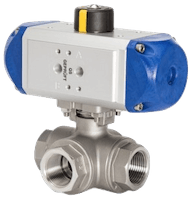
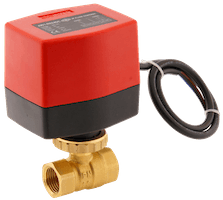
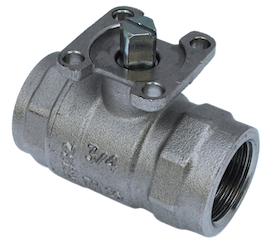
Figure 4: Pneumatic ball valve (left), electric ball valve (middle), ISO-top ball valve (right).
There are several different ways to control an electric actuator:
- A 2-point control (also called an Open-Close or On-Off circuit) uses one control wire in addition to the power wires. Once the control wire is energized, the valve opens electrically. If the control wire is unpowered, the valve closes (electrically or by means of a spring).
- A 3-point control uses two control wires: one for rotating the ball counterclockwise, and one for rotating the ball clockwise. Depending on the application, the most appropriate control can be chosen.
Certain electric actuators can also provide modulation control, which will position the ball valve between 0-100% open/closed. For more information regarding automatic operation, read our article on installing electrically operated ball valves.
Ball valve housing materials
The most common housing materials are brass, stainless steel and PVC (PolyVinyl Chloride). The ball is usually made of chrome plated steel, chrome plated brass, stainless steel or PVC. The seats are often made of Teflon, but could also be made of other synthetic materials or metals. Read our chemical resistance of materials for more information.
Brass ball valve
Brass has the largest market share (Figure 5). Brass is an alloy of copper and zinc and has good mechanical properties. Brass valves are used for (drinking) water, gas, oil, air and many other media. Chloride solutions (e.g. seawater) or demineralized water may cause dezincification. Dezincification is a form of corrosion in which zinc is removed from the alloy. This creates a porous structure with a greatly decreased mechanical strength. A brass housing is ideal for an air ball valve or a ball valve for plumbing. View our manual 2-way brass ball valves or 3-way brass ball valves.
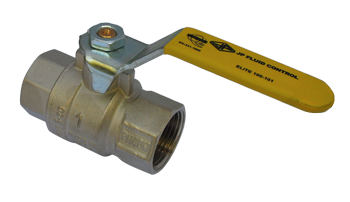
Figure 5: Brass ball valve.
Stainless steel ball valve
Stainless steel is used for corrosive media and aggressive environments (Figure 6). They are therefore often used in seawater, swimming pools, osmosis installations, with high temperatures, and many chemicals. Most stainless steel is austenitic. Type 304 and 316 are the most common, 316 has the best corrosion resistance. 304 is sometimes referred to as 18/8 because of 18% chromium and 8% nickel. 316 has 18% chromium and 10% nickel (18/10). Stainless steel valves usually require a higher operating torque than for example brass or PVC valves. This must be taken into account when a stainless steel valve is operated by an electric or pneumatic actuator. View our manual 2-way stainless steel ball valves or 3-way stainless steel ball valves.
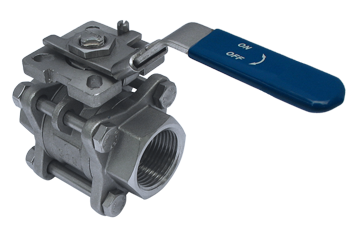
Figure 6: Stainless steel ball valve.
PVC ball valve
PVC often has a lower price (except for ISO-top valves) and is widely used in irrigation, water supply and drainage or corrosive media (Figure 7). PVC stands for polyvinyl chloride. PVC is resistant to most salt solutions, acids, bases, and organic solvents. PVC is not suitable for temperatures higher than 60 °C, and is also not resistant to aromatic and chlorinated hydrocarbons. PVC is not as strong as brass or stainless steel, therefore PVC ball valves have lower pressure rating. Read our article about PVC ball valves for more information about this type of valve.
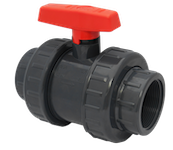
Figure 7: PVC ball valve.
Brass vs stainless steel vs PVC ball valve
| Material | Advantages | Disadvantages |
| Brass | Durable, suitable for most applications | Sensitive to dezincification |
| Stainless steel | Very abrasive resistant, inert, corrosion resistant | Higher price, often more torque needed to rotate the ball |
| PVC | Cost-effective, not prone to corrosion | Shorter lifetime, limited pressure and temperature ranges |
For a comparison between the uses of a ball valve and a butterfly valve, read our butterfly and ball valve comparison article.
Seals and o-rings
Most valve seats are made of PTFE (Teflon). PTFE stands for PolyTetraFluorEthylene. This material has a very good chemical resistance and a high melting point (~327 °C). Besides that, the friction coefficient is extremely low. A small disadvantage of PTFE is that the material shows creep, which can cause a deterioration of the sealing over time. Besides that, PTFE has a rather high thermal expansion coefficient. A solution for this problem is to use a spring in order to apply constant pressure on the Teflon seal, like for example a cup spring. Other popular sealing materials are PTFE and Polyamide (Nylon). The harder the material of the valve seat is, the more difficult it is to maintain proper sealing. For some applications in which soft materials are not possible to use, for example with very high temperatures, metal or ceramic valve seats are used.
High-pressure ball valves
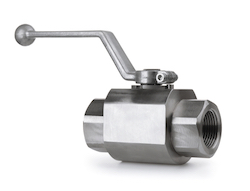
Figure 8: High-pressure ball valve.
As the name suggests, a high-pressure ball valve works under high fluid pressure, approximately 500-700 bars. When the valve size gets bigger, it reduces the pressure it can handle, and vice versa. These valves are highly durable and used in piping systems with connections at the same pressure load. Manual-type high-pressure ball valves can be operated by turning the lever 90 degrees. Motorized high-pressure ball valves are simulated through an electric signal for their operation. Materials like carbon steel and stainless steel 316 are used for the valve’s construction. Duplex or other highly resilient materials should be used to construct valve parts like stem, ball, and seat rings. This helps withstand the valve’s high-pressure ratings and the actuator's maximum allowable stem torque.
High-pressure ball valves are available in the following connection types:
- British standard pipe parallel (BSPP) threaded
- National pipe thread (NPT) threaded
- Compression type (DIN 2353/ISO 8434-1)
- Welding end
High-pressure ball valves are used in those sectors where the fluid is stored in large quantities and used according to their requirements, like water parks, water distribution plants, and chemical industries.
Hydraulic ball valves
Hydraulic ball valves are specially designed for hydraulic and heating systems due to their high operating pressure rating and hydraulic and heating oil resistance. These valves are made of either steel or stainless steel. Besides these materials, the seats also make hydraulic valves suitable for high operating pressure. The seats of these valves are made of polyoxymethylene (POM), which is suitable for high-pressure and low-temperature applications. The maximum operating pressure of hydraulic ball valves goes above 500 bar while the maximum temperature goes up to 80 °C.
Ball valve connection types
Ball valves can be connected to pipes in several ways, making them versatile for various applications. These are their common connection types:
- Standard (threaded): Standard ball valves consist of the housing, seats, ball and lever for ball rotation. They include valves with two, three, and four ports which can be female or male threaded or a combination of those. For more information on a threaded connection, read our ball valve connection types article.
- Flanged: The ports are connected to a piping system via flanges that are usually designed in accordance with a certain standard. These valves provide a high flow rate since they typically have a full-bore design.
Approvals
For certain applications, approvals are desired or required. Drinking water and gas are the most common. Choosing a certified ball valve, assures that the product meets important safety requirements.
Drinking water
These ball valves are suitable for drinking water applications and have a WRAS, KIWA or DVGW approval. If being used with a water holding tank, they often work in connection with a float switch to monitor water level. Additionally, the water ball valve shut off feature ensures a quick and secure means to stop water flow when necessary.
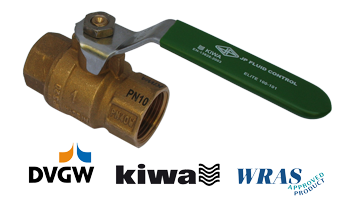
Figure 9: Common drinking water ball valve approvals (DVGW, KIWA, WRAS).
Gas
These ball valves are approved for gas appliances.
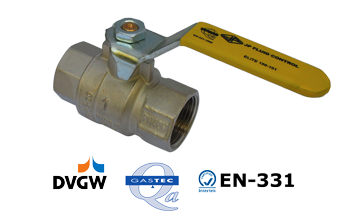
Figure 10: Common gas ball valve approvals (DVGW, GASTEC, EN-331).
FAQs
When is a ball valve open?
A ball valve is open when the handle is in line with the pipe and closed when the valve is perpendicular to the pipe. It only needs to be rotated 90 degrees.
What is a ball valve?
A ball valve is a shutoff valve that controls the flow of a liquid or gas by means of a rotary ball having a bore. They can be operated by a handle or automated with an electric or pneumatic actuator.
How to install a ball valve?
Screw the input and output of the ball valve into your threaded assembly. Ensure the handle is installed correctly (parallel is open) before installation.
Can ball valves fail?
Yes, a ball valve can fail. Common failure types are a damaged seal (valve won't seal 100%) or debris entering the valve (valve won't move).
What can a ball valve be used for?
A ball valve can be used both as a shut-off valve and as a control valve for both liquids and gasses. In the case of a control valve, the bore is usually made in a v-shape.
What is a forged valve?
Forged ball valves are created by shaping the alloys and metals in their solid form. The metals and alloys are bent by heating or with industrial-sized tools that deliver compressive forces to bend the materials.




